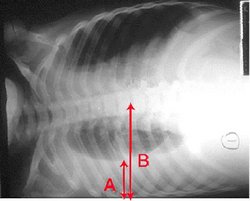INTRODUCTION: Myelomatous pleural effusion is a very rare manifestation of multiple myeloma, and represents the small minority of pleural effusions associated with this disorder. Pleural myeloma has also rarely been associated with mediastinal involvement of malignant plasma cells. We report a case of pleural myeloma associated with mediastinal disease and extrinsic compression of the airway.
CASE PRESENTATION: A 72 year-old white male with a history of coronary artery disease, hypertension, and multiple myeloma was in his usual state of health until eight weeks prior when he developed slowly progressive dyspnea, orthopnea, and wheezing. He denied fever, chills, cough, or chest pain. Four weeks prior he was hospitalized for pneumonia and anemia, and treated with levofloxacin, corticosteroids, and packed red cell transfusions. He had an initial clinical improvement, however, three weeks prior to admission his symptoms recurred despite compliance with his medical regimen. Medical history included multiple myeloma (IgA lambda) diagnosed 4 months prior and treated initially with doxorubicin, prednisone, and vincristine; coronary artery disease status post bypass grafting; hypertension; and diastolic dysfunction. Medications included thalidomide, metoprolol, furosemide, and erythropoietin. Social history was notable for previous tobacco use. Physical exam revealed a chronically ill appearing man who was in no acute distress. Respirations were unlabored and his oxygen saturation was 92% on room air. Brea-th sounds were decreased on the right with dullness to percussion and decreased tactile fremitus. Wheezing was also noted intermittently. Cardiac exam was unremarkable. Initial laboratory exam revealed a WBC 1.3k, Hemoglobin of 7.9 g/dL, and platelets of 32k. Chest radiograph showed a right pleural effusion that had increased in size on serial films. Non-contrast CT of the chest revealed a large loculated right pleural effusion with associated lower lobe atelectasis, and extrinsic compression of the trachea (Figure 1). Ultrasound guided thoracentesis revealed bloody fluid, with WBC 1.5K (differential 88% plasma cells and 6% neutrophils), an LDH of 221 U/L (80% of serum value), a protein of 7.4 g/dL (68% of serum), and glucose of 157 mg/dL. Due to the possibility of airway compression and the atypical pleural effusion, the patient underwent bronchoscopic airway inspection and video assisted thorascopic surgery. Findings included mild external compression of the trachea, and firm, round nodules throughout the pleural surface. Tumor was debulked and talc pleurodesis was performed. Pathology revealed atypical plasma cells consistent with myeloma (Figure 2). Due to the failure of previous chemotherapy regimen, the patient elected to forgo additional treatments and received palliative care. He expired at home 6 weeks later.
[FIGURES 1-2 OMITTED]
DISCUSSIONS: Multiple myeloma is a neoplastic disorder caused by the proliferation of a single plasma cell clone, and is associated with the production of monoclonal immunoglobulin. Pleural effusions occur in approximately 6% of patients with myeloma due to a variety of causes; however, myelomatous pleural involvement occurs in less than 1% of cases. Mediastinal involvement is also quite rare, and may be the source of pleural disease. As in this case, the majority of myelomatous effusions are due to those that produce IgA, as this type tends to invade extraosseous structures. Diagnosis requires immunoelectrophoresis of the pleural fluid or histologic confirmation. Treatment is directed at the underlying disease, but may also include pleurodesis for symptomatic control and appropriate airway management.
CONCLUSION: Myelomatous pleural effusion with mediastinal involvement is a rare manifestation of multiple myeloma, and may mimic infectious complications of the disease. This entity should be considered in those with advanced disease.
REFERENCES:
(1) MG Alexandrakis, FH Passam, DS Kyriakou, D Bouros. Pleural Effusions in Hematologic Malignancies. Chest 2004; 125:1546-52.
(2) JS Kintzer, EC Rosenow, RA Kyle. Thoracic and pulmonary abnormalities in multiple myeloma. Arch Intern Med 1978; 138:727-73.
DISCLOSURE: Steven Rowe, None.
Steven M. Rowe MD * University of Alabama at Birmingham, Birmingham, AL
COPYRIGHT 2005 American College of Chest Physicians
COPYRIGHT 2005 Gale Group



